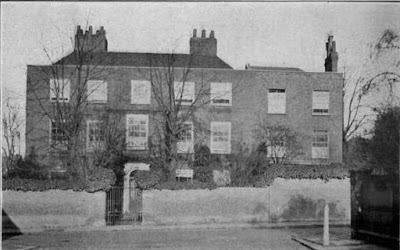This is not such a sensational question as you might think.
Slavery permeated deep into both our economy and our society and contrary to the popularly held belief it was not just the big cities of Liverpool, Bristol and London that benefited from both the Slave Trade and the produce grown and made by slave labour.
And even after the abolition of the trade in 1807 it would be another twenty-six years before slavery itself was abolished and on terms that saw the owners compensated to the tune of £20 million.
So, I am not surprised that “Eight of Eltham’s residents ‘owned’ slaves in 1833. In total they held more enslaved people in the West Indies than the total population of Eltham then”.*
And these eight included familiar names, like Milne, Grant, Pitt-Rivers Currey, Lance Hill, and Warner, who between them were associated with properties like Cliefden House, Danson House, Eltham Lodge, and the Lord Chancellor’s lodgings.
I had always planned to follow up the story of the families who owned slaves in Chorlton-cum-Hardy where I now live, with a similar piece of research on Eltham where I grew up.**
But other projects intervened and now that story has been completed by Margaret Taylor and Sally Simmons, whose article appeared in the latest edition of the Eltham Society’s newsletter.
Never one to steal other peoples’ research or attempt a cack-handed version of their story which has been done so well, I will suggest you read the original piece, which will only require a subscription to the Eltham Society, the aims of which are enshrined in their motto: "Preserving the past, Conserving the present, and Protecting the future".
The article describes the eight families, their connection to slavery and the degree to which they were compensated after the abolition of slavery.
Now I had assumed that most of that taxpayer’s money went to a small group of large plantation owners based mainly in the West Indies, but the final settlement according to Legacies of British Slave-ownership extended to "over 45,000 claimants, and about 3,000 of them were living in Britain in the 1830s. ***
Although claimants living in Britain were in the minority, they tended to own the largest stakes of property; about £10 million of the total £20 million compensation was paid to these 3,000 people in Britain.
Many were very wealthy but there were a wide range of claimants, from rich landowners to widows with children who wrote to the compensation commission complaining of their poverty."
The site and can be found at Legacies of British Slave-ownership, http://www.ucl.ac.uk/lbs/
It is the “umbrella for two projects based at UCL tracing the impact of slave-ownership on the formation of modern Britain: the ESRC-funded Legacies of British Slave-ownership project, now complete, and the ESRC and AHRC-funded Structure and significance of British Caribbean slave-ownership 1763-1833.
Colonial slavery shaped modern Britain and we all still live with its legacies. The slave-owners were one very important means by which the fruits of slavery were transmitted to metropolitan Britain. We believe that research and analysis of this group are key to understanding the extent and the limits of slavery's role in shaping British history and leaving lasting legacies that reach into the present.
The stories of enslaved men and women, however, are no less important than those of slave-owners, and we hope that the encyclopedia produced in the first phase of the project, while at present primarily a resource for studying slave-owners, will also provide information of value to those researching enslaved people.
We are now tracking back to 1763 the ownership histories of the 4000 or so estates identified in that project. At the core of the completed project is this online Encyclopedia of British Slave-ownership containing information about every slave-owner in the British Caribbean, Mauritius, or the Cape at the moment of abolition in 1833.
Entries include information about the activities, affiliations and legacies of these men and women, with a particular emphasis on the "absentee" owners based in Britain.
The records of the Slave Compensation Commission, set up to manage the distribution of the £20 million compensation, provide a more or less complete census of slave-ownership in the British Empire in the 1830s. The individuals named in these records form the starting point of the Encyclopedia.
And the data base can be searched by name, or browsed through the subject headings of “commercial, cultural, historical, imperial, physical and political.”
So, there you have it, I thoroughly enjoyed the article on Eltham’s connection to slavery and share the authors conclusion, that if a small group of “Eltham people were slave owners the other 2, 158 were not”.***
Leaving me just to post a link to the membership page of the Eltham Society.*****
Pictures; Cliefden House Eltham from The story of Royal Eltham, R.R.C. Gregory, 1909 and published on The story of Royal Eltham, by Roy Ayers, http://www.gregory.elthamhistory.org.uk/bookpages/i001.htm in 1977, courtesy of Jean Gammons, and Cliefden House, 2014, from the collection of John King, and detail of Eltham High Street, 1844 from the Tithe map for Eltham courtesy of Kent History and Library Centre, Maidstone, http://www.kent.gov.uk/leisure_and_culture/kent_history/kent_history__library_centre.aspx
*Coronavirus and the Lockdown, Margaret Taylor and Sally Simmons, The Eltham Society Newsletter 222, December 2020, The Eltham Society, http://www.theelthamsociety.org.uk/
**Slavery, https://chorltonhistory.blogspot.com/search?q=slavery
***Legacies of British Slave-ownership, http://www.ucl.ac.uk/lbs/
****ibid Coronavirus and the Lockdown, page 31
*****Eltham Society, http://www.theelthamsociety.org.uk/membership.html





No comments:
Post a Comment